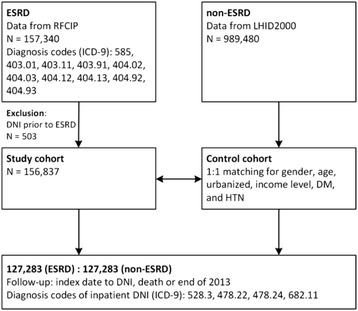Fig. 1.

Enrolment schema of the study and comparison cohorts. Patients with ESRD were identified since 1997 to 2013 in Taiwan from RFCIP database, and a total of 157,340 cases were collected. 503 cases were excluded due to DNI occurrence prior to the index date of ESRD. A total of 156,837 cases with ESRD were eligible for a study cohort. LHID2000 database consisting of 989,480 insurants representing the general population in Taiwan was used to match with the study cohort for gender, age, urbanized, income level, DM and HTN with 1:1 fusion. Finally, there were 127,283 patients with ESRD (study group) and 127,283 patients without ESRD (control group) to conduct the follow-up study. The follow-up ended on DNI identified based on the ICD-9 codes of 528.3, 478.22, 478.24, and 682.11, death, or the end of 2013. Abbreviations: ESRD, end-stage renal disease; RFCIP, Registry for Catastrophic Illness Patients; LHID2000, Longitudinal Health Insurance Database 2000; DNI, deep neck infection; ICD-9, International Classification of Diseases, Ninth Revision; DM, diabetes mellitus; HTN, hypertension
